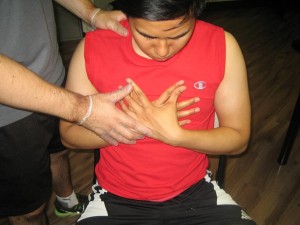Costochondritis involves inflammation in the cartilage that connects a rib to the sternum. Always bear in mind that this inflammation can trigger localized piercing pain or discomfort in the joint of the rib and sternum that can be aggravated if the individual takes in deep breaths, sneezes, coughs or performs other movements that moves the ribs and pulls on the cartilage in between the ribs and the breastbone. Certain lifestyle activities and infections are also considered factors linked to costochondritis.
https://www.youtube.com/watch?v=kCTFNz93T5s
What is exercise-induced costochondritis?
Costochondritis has been linked to heavy lifting and strenuous exercise. In some circumstances, individuals who suffer from costochondritis engaged in a form of laborious or strenuous activity such as lifting heavy objects before experiencing the symptoms.
Incorrect form or technique during weightlifting, a traumatic blow to the chest during sports or lifting heavy weights is contributing factors to the condition. In case the individual experiences chest pain that might be due to physical exertion, it is best to ease up on the exercise routine and consult a doctor regarding safe guidelines for the exercise program or weightlifting.

What are the other causes?
The exact cause of costochondritis is still unclear. Aside from the exercise-related factors, bacterial or viral infections, upper respiratory illness, fibromyalgia or trauma around the chest area are potential factors that can influence or cause costochondritis.
Exercise concerns
If the individual engages in regular strenuous exercise or activity such as heavy weightlifting, it is important to allow the body enough time to rest and heal for several days.
Always bear in mind that exercises can cause an increase in the breathing rate and depth, thus requiring increased movement of the ribs. With this in mind, intense cardio exercises must be avoided. The individual can still perform light stretching of the upper back and limbs but not to the point of pain.
Mild exercises such as walking or swimming can help improve the mood and keep the body healthy at the same time. Light stretching of the pectoral muscles 2-3 times a day might be beneficial to the condition. When the pain fully subsides, it is time to ease back to normal activities and exercise routine.
Management
The pain due to costochondritis typically subsides in a few days or weeks. The best way to reduce the discomfort is to provide pain medications such as acetaminophen or ibuprofen. If the individual experiences constant piercing pain or discomfort in the chest, it is vital to set an appointment with a doctor for an accurate diagnosis of the condition. In addition, a heating pad can be used at the lowest setting several times throughout the day.
